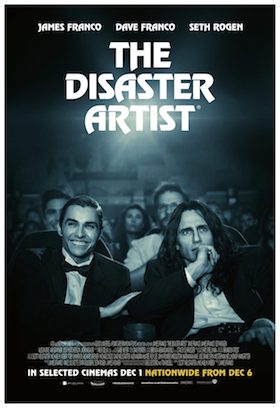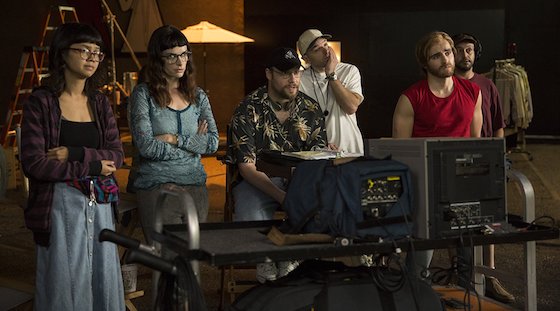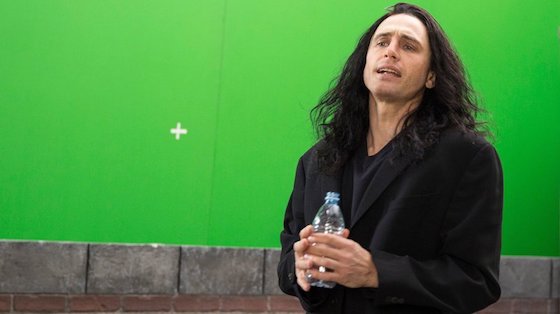
[Solid Rock Fist Up]

The first scene of The Disaster Artist takes place in an acting workshop, where aspiring thespian Greg Sestero (Dave Franco) is getting dressed down by his coach for a lack of commitment and confidence. His scenes need passion, she says, as well as a willingness to be open, exposed, and vulnerable. When the coach asks the rest of the class if anyone is willing to take just such a leap, Tommy Wiseau (James Franco) emerges from the shadows, and gives a wild and flailing rendition of the “Stella!” scene from A Streetcar Named Desire. It’s awful, unfocused, and halting, to be sure: but it is honest and fearless, too.
This seems to get at the heart of what The Disaster Artist is trying to say, for it is a movie that celebrates the willingness of any artist to give everything to their craft. Like his “Stella!” scene, when Tommy Wiseau wrote, produced, financed, and starred in his own movie, The Room, he did so with a total disregard for what anyone else thought or said, and plowed ahead to put his artistic vision out there. This resulted in what many well-informed critics and students of film have dubbed the worst movie ever made, but it also gave birth to a cinematic subculture that champions dreamers and artists who go at their craft with a damn-the-torpedoes attitude.
Adapted from the non-fiction book of the same name by Sestero, The Disaster Artist is based on Sestero’s relationship with Wiseau, which grew from a casual acquaintance via their acting workshop to a full-fledged partnership when the pair made The Room in 2002 and 2003. The movie follows the pair moving to Los Angeles together in the late-90s to try and break into the business, largely supported by a reserve of cash whose origins Tommy never explains (and still hasn’t to this day). And while Greg has limited success in Hollywood because of his good looks and affable demeanor, Tommy doesn’t fare as well. Casting directors, producers, and acting coaches all tell Tommy versions of the same story: he’ll never “make it.”
This is entirely understandable, too, because whatever enthusiasm and fearlessness Tommy may have is counterbalanced by his somewhat ghoulish looks, sometimes indecipherable accent, and a stoic unwillingness to absorb feedback that doesn’t feed into his delusions of grandeur. Yet for all the weirdness and the mysteries that surround Tommy (and there are several, including where he is originally from and how old he is), one serves him very well: his wealth. This allows him to bypass the gatekeepers of Hollywood so that he can just star in his own movie, which he approaches with the same reckless abandon that has seen him through to this point.
And as for Tommy’s movie, well…what can one say about The Room that hasn’t already been said? From top to bottom it is a clinic in not just bad filmmaking, but atrocious storytelling. The plot, such as it is, rarely makes sense and meanders in and out of narratives that rarely develop (and sometimes just disappear). The acting is subpar (with Wiseau being a notable standout amongst the worst offenders), the cinematography is flat (owing to the fact that Wiseau insisted that the movie be shot on both HD and film), the set design is schizophrenic, sound mixing is abysmal, the wardrobe choices are bonkers, and unnecessary special effects litter the production. Oh, and at times, The Room is also out of focus.
Put simply, Wiseau’s film is bad in every conceivable way a motion picture can be. As it proceeds into its second act, The Disaster Artist follows the production of this spectacular failure, from Wiseau’s insistence that all camera equipment be bought, not rented, to the filming of scenes on constructed sets of alleys directly across from actual, perfectly filmable alleys. It’s a bumpy ride filled with uncomfortable open-set sex scenes, an exasperated script supervisor (Seth Rogan in an understated, scene-stealing role), a bewildered cast, and an incredulous crew.
As a director, James Franco takes the time to demonstrate that what made Wiseau successful also doomed his art, as the dedication and resilience that Tommy used to get his film made also kept him from taking any constructive feedback. After all, Tommy got The Room made by ignoring all his critics and naysayers, so it would stand to reason that he would take that same attitude into production. James Franco plays Tommy as a contradiction of personalities that vary from petty to generous and everything in between. He manages to keep things balanced as both an actor and director, keeping the film clicking at a good, light pace while turning in the best performance of his career. His scenes with his brother Dave crackle with a dangerous spontaneity that fits in with the gonzo universe this story lives in, and breathe life into a very weird yet touching relationship.
And while The Disaster Artist takes some shortcuts to get to its thematic climax, it does what it sets out to do: it celebrates the audacity of hope. Sure, Wiseau got lucky that his self-financed vanity project caught on as a kitsch masterpiece (disasterpiece?), yet that doesn’t make the celebration of his failure any less special. Opening today, The Disaster Artist is essential viewing for fans of The Room, and a fun time for those that aren’t. It is an improbable success story that looks at one man’s dream, warts and all, and shows what blind ambition, bottomless pockets, and fearlessness can achieve.







Comments on this entry are closed.